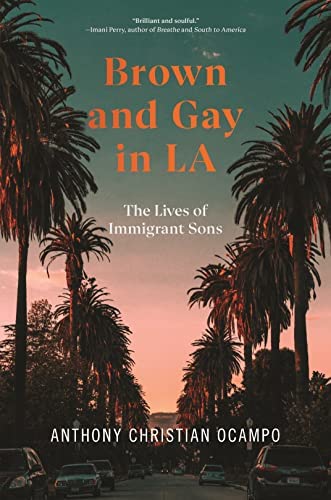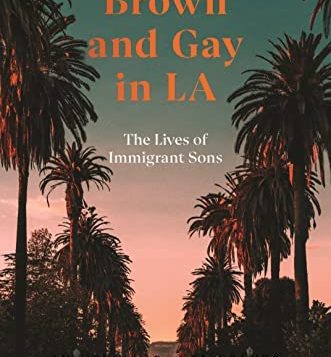 BROWN AND GAY IN LA
BROWN AND GAY IN LA
The Lives of Immigrant Sons
by Anthony Christian Ocampo
NYU Press. 207 pages, $28.
SOCIOLOGIST Anthony Christian Ocampo’s Brown and Gay in LA strikes close to home on so many levels. The author grew up in Eagle Rock, a neighborhood of Los Angeles next door to where I live now. The impetus for this research project began during his graduate student days at UCLA as he was exploring his own sexuality in West Hollywood. While preparing his dissertation (published in 2016 as The Latinos of Asia: How Filipino Americans Break the Rules of Race), Ocampo was also meeting some of the Filipino and Latino gay men who would later become his informants for the current study. He and they recount their nights at the gay clubs of WeHo, as well as the discos catering more specifically to Latinos or Asians. That took me back to my own euphoric times at Circus Disco and Arena—huge Hollywood nightclubs that were demolished in 2016 to make way for luxury condos.
Ocampo (now a sociology professor at California State Polytechnic University, Pomona) formalized the project to focus on second-generation Filipino-American and Latino (primarily Mexican) men who identified as “gay” (or in a few cases “queer”). He defines “second generation” as those born in the U.S. with one or both parents born abroad. Besides those recruited at clubs, about a third of his 63 subjects were recruited from local universities like UCLA. They were between the ages of 18 and 36 when they were interviewed from 2012 to 2016. His sample skews toward men with higher education and middle-class or higher socioeconomic status. Ocampo himself is a gay Filipino, and his dissertation points to his rationale for grouping Filipinos with Latinos (rather than with other Asians).
Ocampo analyzes with great empathy the struggles of his informants as gay children of immigrants, often with non-English-speaking families, conservative values, and Roman Catholic mores. Although Filipino-American immigrants tend to have higher educational and professional backgrounds than Latino families, both groups are very family-focused. Like many immigrant families in the U.S., the parents hope their sacrifices and hard work will pay off in their children’s educational attainment, financial advancement, and, of course, grandchildren. This can be a challenge for any second-generation American man or woman. A distinctive challenge for Ocampo’s gay subjects is the deeply entrenched association of gays with effeminacy. Their experience of homophobia regularly takes the form of ridiculing, policing, or outright beatings for unmasculine behavior (as culturally defined). This is somewhat surprising for the Filipinos, since bakla (natal men presenting a feminine gender role) are common in society and on television in the Philippines. And while the Filipino-American gay men did not consider their homeland a homophobic country, they grew up knowing that their families didn’t want them to be bakla. Both Filipinos and Latinos alike suppressed any feminine behaviors or struggled to be “masculine,” and, when that failed, they faced hostility from family, peers, and priests. The association of gays with effeminacy, immorality, and AIDS is all too common across the U.S.
Many of Ocampo’s subjects found a “cover” in academics and school leadership. If you can’t be an athlete, being a nerd could at least earn your parents’ support and was a plausible reason for not dating girls. Many also sought a cover with a girlfriend. An academic focus had many (perhaps unexpected) bonuses: being mentored by a teacher, being the first in the family to go to college, and moving to another city where you can explore your sexuality. Where the two cohorts differ is how Latino versus Filipino students were treated by family and educators, depending on the class and racial demographic of their schools. Ocampo references broader research highlighting the lower academic expectations and behavioral stigmatization of Latino boys versus the “model minority” status of Filipinos (seen as Asian-American). Some of the Latino gay boys could take advantage of teacher bias to shine as one of the “smart kids.” Perhaps because of when these men were in school (1980’s and ’90s) or the socioeconomics of the school, few of them recalled having an LGBT support group, which is now common (at least in the wealthier neighborhoods of L.A.).
Most of the subjects found the support to come out when they were in college or started going to gay nightclubs and small parties. College LGBT groups were undoubtedly invaluable for many gay men of all races. Attending gay Latino clubs was a revealing moment for these gay men, just as I remember it being for me in the 1990s. They had far more racial and class diversity than did WeHo, where white twinks and gym clones ruled. The Latino clubs shattered the association of gays and effeminacy—even while reinforcing them. On the one hand, many patrons were tatted up and “sagging’ and indistinguishable from other “homeboys,” “cholos,” or “gang bangers” in rough parts of L.A. On the other hand, clubs also had (great) drag shows. Club Tempo most distinctly emphasized the masculine-feminine divide: on the first floor, gay vaqueros (cowboys) danced in pairs to banda music, while the second floor had the drag queens and disco.
The informants date themselves by their other source of gay connectivity: internet chat rooms like AOL Instant Messenger. Much like printed personal ads in the pre-Internet era, chat rooms allowed gay men to meet across divides of neighborhoods, race, and class. Yet, as some informants point out, chat rooms could also reinforce racial preferences or the desirability of “straight acting” men. Not included in this study are men who have sex with men but may not consider themselves gay.
Coming out was traumatic for most of these men: less a joyful reveal than a shameful confession. For many there had been a convenient collusion of silence to save face in the family. There were different reactions to learning the truth: some family members blamed themselves, a few were supportive, but (notably) only one gay teen was kicked out of the house. Only a few were taken to a therapist for “conversion.” I’m relieved to read that no therapist agreed to this, but instead encouraged family acceptance. This came slowly and grudgingly for some of the men thanks to their eventual professional success. Some even ended up financially supporting their hostile parents—the ultimate expression of family values.
Ocampo’s conclusion is poignantly bittersweet: “the survival of the second-generation gay men took the form of suppression, assimilation, and overachievement.” However, these are the brown gay men who have succeeded. My work as a psychiatrist in community clinics in L.A. also introduced me to gay men (Brown and White) who don’t succeed—who end up on the streets, dropping out of school, turning tricks, using drugs. But these are not Ocampo’s subjects. He has a different story to tell, which strikes overwhelmingly close to home as a Brown and gay man in L.A. Although I am first-generation South Asian, his subjects’ stories—thoughtfully evoked and beautifully narrated—is my story. At the same time, this book speaks broadly to gay men in general, from families steeped in religion and “traditional values” struggling to succeed in America even at the cost of rejecting their LGBT children.
Vernon Rosario is a child psychiatrist with the Dept. of Mental Health in L.A. and an associate clinical professor of psychiatry at UCLA.






